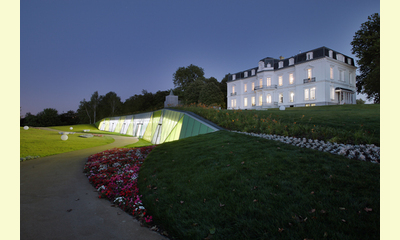|
|
A House for Peace in the Basque Country
un articulo por Manuel Dios Diz, chair of the Galician Seminar of Education for Peace (excerpt)
I had the opportunity to get to know the House of Peace of San Sebastian, invited by the previous mayor, Odon Elorza, who is personally involved with that project. Indeed, the cultural capital of Donostia has always been identified with the pursuit of peace, coexistence and reconciliation.

House of Peace and Human Rights of San Sebastian (from website of Odon Elorza)
click on photo to enlarge
It is located in a magnificent room in the Palace of Aiete, a symbolic place for many reasons. It is there that the dictator lodged on his visits. It was also a center of torture of Lasa and Zabala, a terrible episode of the "dirty war" against ETA.
The top floors of the building, the palace, retains the structure and appearance of the times when it was occupied by Franco. However, the rooms, lounges and others are now devoted to research activities for peace, consciousness raising, dissemination and training. When I visited, accompanied by Churi Aramburu and several friends of Etxea UNESCO and the Coordinating Group for Peace and Human Rights in the Basque Country, it was still under construction. We could see that the programming of the contents had begun.
On the bottom floors, underneath the palace itself, under the earth and green turf, with independent access, much more modern, were spaces for workshops, exhibitions, etc.. with large photographs of the Nobel peace prize winners giving welcome.
Odon Elorza was very excited with the design of the House of Peace and linking with the recovery of Aiete neighborhood and a very special end to the violence and the need to build democratic coexistence, based on dialogue and reconciliation. Those magnificent spaces, where national or international activities can be realized, were appropriate for the sake of those goals. Once the violence is over begins the most complex stage, to make amends, he said. However, the construction of peace has already begun, and this place is a symbol of a process that can be seen as irreversible . . ..
Maybe some would prefer another symbol. Something like "cautivo y derrotado el ejército rojo." which was signed by Franco to end the Civil War in 1939. But this is not that kind of conflict. Others would perhaps prefer the public removal of hoods and berets, or executions in the public square.However, reconciliation, concord and peace are not achieved in, this way. The unification of the stories, the memory of what happened, must be constructed without exclusions and with forgiveness, as Johan Galtung says, after the violence, the three R's: reconstruction, reconciliation, resolution, to address the visible and invisible effects of violence.
Versailles had its image, which we studied in our youth, like Yalta, South Africa and El Salvador, and Guatemala, and Ireland ... if ETA announced its definitive end, I like the image of Aiete Palace, the House of Peace of San Sebastian, why not?.
(This article is continued in the discussionboard with an analysis of the ETA Declaration - see righthand column of this page)
Click here for a Spanish version of this article.
|








|
DISCUSSION
No hay pregunta ligada a este article.
* * * * *
Comentario más reciente:
(The following is continued from the main article listed above.)
Finally! The ETA Declaration of October 20, 2011
I believe sincerely that all the people of peace and well-being, from everywhere, be it the Basque region, or Galicia, or other Spanish nationalities, or France, or other countries of the world, today, must be moved and full of happiness. The Declaration made public the 20 of October of the 2011, on the part of ETA, announcing definitive end of its armed activity, is extraordinary news!
Our great happiness is dimmed, of course, by the memory of all the victims (so many!) , who are gone forever, as a result of this interminable armed conflict that lasted more than 50 years. Some lived all their existence with the violence on ETA constantly present in their life.
Perhaps we do not yet perceive the complete significance of this Declaration. We cannot yet evaluate, in a way that is rigorous and calibrated, its relevance, because we are so deeply affected by the influence of the news, by so many emotions that come together, positive and negative, because we can only barely imagine the ways of hope for the repair of the damage that has been caused, for the reconstruction of so many broken lives, reconciliation for the democratic coexistence, routes that are not easy but that are essential, both personally and collectively. Peace, or more precisely "peaces", in plural, all the aspects of peace, now must be constructed, every day, all days, on the base of confidence, security, dialogue, nonviolence and freedom.
The Declaration of ETA, in its terms and contents, cannot completely satisfy us. That would be impossible. The manner of its presentation was, once again, lamentable. . ... continuación.

|
|









